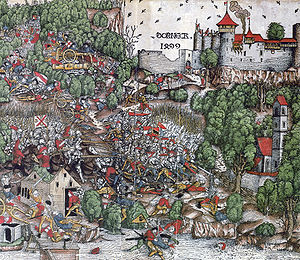Heap of violence

A heap of violence denotes the main formation of the quarter heap , the most efficient and generally widespread massive battle order in Europe from the Middle Ages to the early modern period . The advance guard and the rear guard were also part of the heap of four .
The term is primarily applied to the formations of the Swiss confederates during their wars against Habsburg and Burgundy in the late Middle Ages , primarily from the mid- 15th century when they introduced pikemen to their peasant army. These formed a protective frame around the rest of the melee fighters with their halberds and other weapons. They were supposed to fend off the knights' lance attacks and overwhelm opposing infantry with the superior range of their pikes. Then the others should rush forward between the ranks and destroy the enemy. The warriors armed with firearms fought outside the formation as tirailleurs . The Swiss usually formed three groups: the vanguard, the violent groups as the main power, and the rear guard.
The German Landsknechte were the first to adopt this tactic around 1500 . With them, however, the formation was deeper and now included more pikemen than other melee fighters . However, a large number of halberdiers and a small elite of two-handed swordsmen survived for the time being . In addition, the pile was "stratified"; That is, it was divided into flat formations, sometimes only six limbs deep, which were placed one behind the other with some distance. Each had pikemen in front and on the flanks, the rearmost also in the back; in the back (or in the middle) stood the others. In this way, the heap could still be used effectively when the front rows of pikemen were broken. In Spain in particular, Rondar barges were often used instead of other hand-to-hand combatants. These wore round, arched shields ( tarts ) made of solid steel, on which arquebus balls that were fired from over 100 m away were supposed to ricochet off. With these they could protect the pikemen in case of fire. After clashing with the enemy, they took on the role of the halberdiers, their weapon was the sword .
Before the middle of the 16th century , the Tercio developed in Spain , which was to become a model: The pikemen were now less deep again, i.e. roughly square. The stratification was abolished along with the other hand-to-hand combatants. The commanders, standard-bearers, and musicians who previously stood between them were now placed in a cavity inside the pile. Riflemen with arquebuses were set up on the flanks or around them to fire in counter- march. Musketeers were placed at the corners for the first time . These became more and more numerous, from around 1600 onwards they finally began to displace the arquebusiers that had already declined. In the late 16th century, several Tercios were deployed to the Spanish brigade using a 1-2-1 or 2-3-2 meeting tactic .
In addition, there were arrangements in which the cavity was larger so that the arquebusiers (placed more flat) could retreat there. In order not to disturb the order of the pikemen, they were soon divided into several segments so that the formation could "open up". This tactic was used in the Turkish Wars to protect the riflemen from the light, flexible cavalry of the Ottomans and their allies.
In the second phase of the Eighty Years' War from 1621, the dreaded Spanish Tercios were more and more troubled or defeated by the rebellious Dutch who - outnumbered - were able to take advantage of their much more structured meeting tactics . The Battle of Rocroi on May 19, 1643, which ended in a devastating defeat for the Spaniards against France, marked the end of this tactical formation, which proved to be outdated. Nevertheless, slaughterhouses based on the Tercio model were used in the Catholic armies well beyond the Thirty Years' War , but increasingly supplemented or replaced by the more modern regiments .
Individual evidence
- ^ Dictionary of German military history. Vol. 1: A– Me. Military publishing house of the German Democratic Republic, Berlin 1985, ISBN 3-327-00239-8 , p. 254.